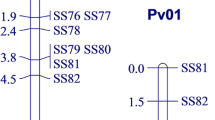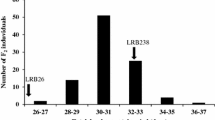Abstract
The Guatemalan black bean (Phaseolus vulgaris L.) plant introduction (PI) 181996 is resistant to all known US races of the bean rust fungus Uromyces appendiculatus (Pers. ex Pers.) Unger var. appendiculatus [syn. U. phaseoli (Reben) Wint.]. We report on two random amplified polymorphic DNA (RAPD) markers OAC20490 tightly linked (no recombinants) in coupling phase and OAE19890 linked in repulsion phase (at 6.2±2.8 cM) to PI 181996 rust resistance. These RAPDs, generated by single decamer primers in the polymerase chain reaction, were identified in near-isogenic bulks of non-segregating resistant and susceptible BC4F2 (NX-040*4/PI 181996) lines. Linkage of the RAPD markers was confirmed by screening 19 BC4F2 and 57 BC4F3 individuals segregating for PI 181996 resistance. Utility of the RAPDs OAC20490 and OAE19890 was investigated in a diverse group of common bean cultivars and lines. All cultivars into which the PI 181996 resistance was introgressed had the RAPD OAC20490. A RAPD similar in size to OAC20490, observed in some susceptible common bean lines, was confirmed by Southern blotting to be homologous to the RAPD OAC20490. Use of the RAPDs OAC20490 and OAE19890 in marker-assisted selection (MAS) is proposed. The coupling-phase RAPD is most useful for MAS of resistant BCnF1individuals during traditional backcross breeding. The repulsion-phase RAPD has greatest utility in MAS of homozygous-resistant individuals in F2 or later-segregating generations.
Similar content being viewed by others
References
Afanador LK, Haley SD, Kelly JD (1993) Adoption of a “mini-prep” DNA extraction method for RAPD marker analysis in common bean (Phaseolus vulgaris L.). Annu Rep Bean Improv Coop 36:10–11
Barua UM, Chalmers KJ, Hackett CA, Thomas WTB, Powell W, Waugh R (1993) Identification of RAPD markers linked to a Rhynchosporium secalis resistance locus in barley using nearisogenic lines and bulked segregant analysis. Heredity 71:177–184
Grafton KF, Chang KC, Venette JR, Vander Wal AJ (1993) Registration of ‘Norstar’ navy bean. Crop Sci 33:1405–1406
Haley SD, Miklas PN, Stavely JR, Byrum J, Kelly JD (1993 a) Identification of RAPD markers linked to a major rust resistance gene block in common bean. Theor Appl Genet 86:505–512
Haley SD, Afanador L, Kelly JD (1993 b) Further optimization of random amplified polymorphic DNA (RAPD) analysis in common bean. Annu Rep Bean Improv Coop 36:12–13
Haley SD, Afanador LK, Miklas PN, Stavely JR, Kelly JD (1994 a) Heterogeneous inbred populations are useful as sources of nearisogenic lines for RAPD localization. Theor Appl Genet 88:337–342
Haley SD, Afanador L, Kelly JD (1994 b) Selection for monogenic pest resistance traits with couplingand repulsion-phase RAPD markers. Crop Sci 34:1061–1066
Hansen H, Hilmar L, Bodner U (1993) Rapid and simple purification of PCR products by direct band elution during agarose-gel electrophoresis. Biotechniques 14:28–30
Kelly JD, Stavely R, Miklas P, Afanador L, Haley SD (1993) Pyramiding rust resistance genes using RAPD markers. Annu Rep Bean Improv Coop 36:166–167
Kesseli RV, Paran I, Michelmore RW (1992) Efficient mapping of specifically targeted genomic regions and the tagging of these regions with reliable PCR-based genetic markers. Proc Symp Applications of RAPD Technology to Plant Breeding. Joint Plant Breeding Symposia Series. 1 Nov Minneapolis, pp 31–36, ASA, Madison, WI
Kolmer JA, Groth JV (1984) Inheritance of a minute uredium infection type of bean rust in bean breeding line 814. Phytopathology 74:205–207
Luann Finke M, Coyne DP, Steadman JR (1986) The inheritance of resistance to rust, common bacterial blight, plant habit and foliar abnormalities in Phaseolus vulgaris L. Euphytica 35:969–982
Melchinger AE (1990) Use of molecular markers in breeding for oligogenic disease resistance. Plant Breed 104:1–19
Michelmore RW, Paran I, Kesseli RV (1991) Identification of markers linked to disease resistance genes by bulked segregant analysis: a rapid method to detect markers in specific genomic regions using segregating populations. Proc Natl Acad Sci USA 88:9828–9832
Miklas PN, Stavely JR, Kelly JD (1993) Identification and potential use of a molecular marker for rust resistance in common bean. Theor Appl Genet 85:745–749
Paran I, Michelmore RW (1993) Development of reliable PCR-based markers linked to downy mildew resistance genes in lettuce. Theor Appl Genet 85:985–993
Pedersen WL, Leath S (1988) Pyramiding major genes for resistance to maintain residual effects. Phytopathology 26:369–378
Stavely JR (1984) Genetics of resistance to Uromyces phaseoli in a Phaseolus vulgaris line resistant to most races of the pathogen. Phytopathology 74:339–344
Stavely JR (1990) Genetics of rust resistance in Phaseolus vulgaris plant introduction PI 181996 (abstract). Phytopathology 80:1056
Stavely JR, Batra LR (1991) Recently identified new pathogenic varability in Uromyces appendiculatus (abstract). Phytopathology 81:704
Stavely JR, Pastor-Corrales MA (1989) Rust. In: Schwartz HF, Pastor-Corrales MA (eds) Bean production problems in the tropics, 2nd edn. CIAT, Cali, Colombia, pp 159–194
Stavely JR, Steadman JR, McMillan RT Jr (1989) New pathogenic variability in Uromyces appendiculatus in North America. Plant Dis 73:428–432
Stavely JR, Steinke J, McMillan RT Jr, Grafton KF, Steadman JR, Kelly JD, Coyne DT, Lindgren DT, Silbernagel JM (1992) Rustresistant bean germplasm releases. Annu Rep Bean Improv Coop 35:228–229
Stavely JR, Kelly JD, Grafton KF (1994) BelMiDak-rust-resistant navy dry bean germplasm lines. HortScience 29:709–711
Suiter AK, Wendel JF, Case JS (1983) LINKAGE-1: a PASCAL computer program for the detection and analysis of genetic linkage. J Hered 74:203–204
Velez-Martinez H, Lopez-Rosa J, Freytag GF (1989) Determination of yield loss caused by rust [Uromyces phaseoli (Reben) Wint] incommon bean (Phaseolus vulgaris L) in Puerto Rico. Annu Rep Bean Improv Coop 32:134–135
Weeden NF, Timmerman GM, Hemmat M, Kneen BE, Lodhi MA (1992) Inheritance and reliability of RAPD markers. Proc Symp Applications of RAPD Technology to Plant Breeding. Joint Plant Breeding Symposia Series. 1 Nov Minneapolis, pp 12–17, ASA, Madison, WI
Author information
Authors and Affiliations
Additional information
Communicated by P. L. Pfahler
Mention of a trademark or a proprietary product does not constitute a guarantee or warranty of the product by the USDA and does not imply its approval to the exclusion of other products that may also be suitable.
Rights and permissions
About this article
Cite this article
Johnson, E., Miklas, P.N., Stavely, J.R. et al. Coupling- and repulsion-phase RAPDs for marker-assisted selection of PI 181996 rust resistance in common bean. Theoret. Appl. Genetics 90, 659–664 (1995). https://doi.org/10.1007/BF00222130
Received:
Accepted:
Issue Date:
DOI: https://doi.org/10.1007/BF00222130




